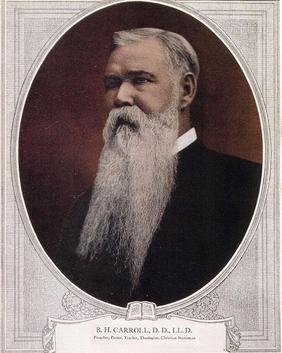Benajah Harvey Carroll facts for kids
Quick facts for kids
Benajah Harvey Carroll
|
|
|---|---|
 |
|
| 1st President of Southwestern Baptist Theological Seminary | |
| In office 1908–1914 |
|
| Preceded by | None |
| Succeeded by | Lee Rutland Scarborough |
| Personal details | |
| Born | December 27, 1843 Carroll County, Mississippi |
| Died | November 11, 1914 (aged 70) Waco, Texas |
| Nationality | American |
| Parents | Benajah and Mary Carroll |
| Alma mater | Baylor University |
| Occupation | Theologian, Seminary President, Author, Pastor, Educator |
| Military service | |
| Allegiance | |
| Branch/service | Texas State Militia Confederate States Army |
| Years of service | 1862-1864 (C.S.A) |
| Unit | 17th Texas Infantry |
| Battles/wars | American Civil War |
Benajah Harvey Carroll, also known as B. H. Carroll, was an important Baptist pastor, theologian, teacher, and author. He was born on December 27, 1843, and passed away on November 11, 1914. He is best known for helping to start the Southwestern Baptist Theological Seminary.
Contents
Early Life and Beliefs
Carroll was born in Carroll County, Mississippi, near a town called Carrollton. He was one of twelve children. His father was also a Baptist minister. In 1858, when Benajah was about 15 years old, his family moved to Burleson County, Texas.
Carroll served in the army during the American Civil War from 1862 to 1864. After the war, in 1865, he became a Christian at a Methodist camp meeting. He later married Ellen Virginia Bell. After she passed away, he married Hallie Harrison in 1899.
Carroll became a very important leader for Baptists in Texas and across the Southern United States. He helped create the Baptist General Convention of Texas. He was known for being strong in his beliefs and for debating important topics.
Carroll believed strongly in the power of the Holy Spirit. He thought that churches, guided by the Holy Spirit, would help many people become Christians. He believed that Christ would return to Earth after this happened. He also strongly believed that the Bible was completely true and without error.
Founding a Seminary
Carroll played a key role in starting the Southwestern Baptist Theological Seminary. He helped found this school in Fort Worth, Texas in 1908. The seminary moved from Waco to Fort Worth in 1910. He served as the president of the seminary until he passed away.
Family and Writings
Carroll's younger brother, James Milton Carroll, was also a well-known Baptist leader in Texas. Benajah's son, B.H. Carroll Jr., became a school superintendent. A school district in Southlake, Texas, is named after him.
Carroll wrote many books and articles. He published 33 volumes of his works. He is most famous for his 17-volume commentary called An Interpretation of the English Bible. Benajah Harvey Carroll passed away on November 11, 1914. He is buried in Oakwood Cemetery in Waco, Texas.
Legacy and Influence
Years after Carroll's death, his writings became very important during a time when Southern Baptists were discussing the Bible's truthfulness. Leaders like Harold Lindsell and W. A. Criswell looked to Carroll's ideas. They saw his work as a strong example of the historic Baptist belief that the Bible is fully true.
Paige Patterson, who later became president of Southwestern Seminary, also saw Carroll's work as very important. Carroll's ideas helped shape many discussions within the Southern Baptist Convention.
Prominent Students
- Walter Thomas Conner
See also
 In Spanish: Benajah Harvey Carroll para niños
In Spanish: Benajah Harvey Carroll para niños
- Southwestern Baptist Theological Seminary
- B. H. Carroll Theological Institute
- List of Baptists
- List of preachers

